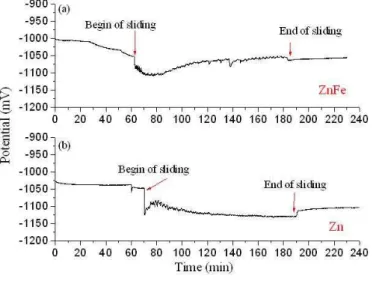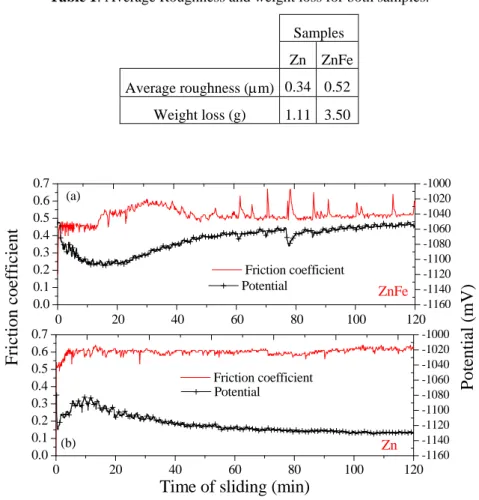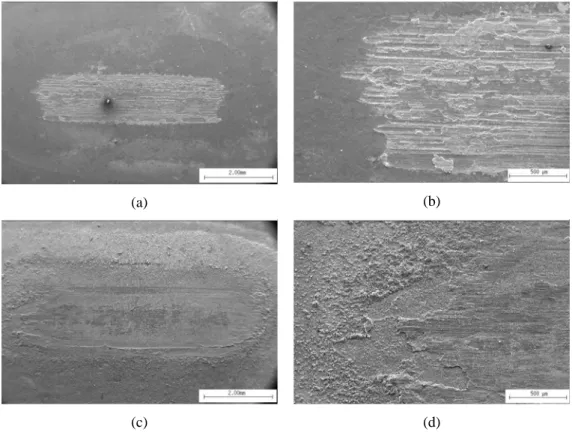ISSN 1 5 1 7 - 7 0 7 6
Revista Matéria, v. 12, n. 4, pp. 618 – 623, 2007 http://www.materia.coppe.ufrj.br/sarra/artigos/artigo10709
Comparative behaviour in terms of wear and corrosion resistance of
galvanized and zinc-iron coated steels
SOUZA, Maria Eliziane Pires I; ARIZA, Edith II; BALLESTER, Margarita III; ROCHA, Luís Augusto II, IV; FREIRE, Célia M. A. I
I
Department of Materials Engineering, Faculty Mechanical Engineering UNICAMP, C.P. 6122, 13083-970, Campinas, São Paulo, Brasil. Tel: +55 19 3788 3313
e-mail: elizianeps@yahoo.com , celia@fem.unicamp.br
II
Centre for Mechanical and Materials Technologies,
Campus de Azurém, 4800-058, Guimarães, Portugal. Tel:+351253 510231, e-mail: edith@dem.uminho.pt
III
Applied Physics Department, Physics Institute
UNICAMP, C.P. 6039, Campinas, São Paulo, Brasil. Tel: +55 19 3788 5383, e-mail: bmarga@terra.com.br
IV
Department of Mechanical Engineering, University of Minho Campus de Azurém, 4800-058, Guimarães, Portugal. Tel:+351 253 510220.
e-mail: lrocha@dem.uminho.pt
ABSTRACT
Materials degradation due to simultaneous chemical and mechanical effects may occur under a variety of conditions. Galvanized and zinc-iron electrodeposited steels are widely used to protect automobile bodies against corrosion. In such applications, it is important to investigate the electrochemical and tribological behaviour of the coatings, in order to understand the behaviour of those surfaces in a tribological contact exposed to a corrosive environment. In the present paper, the evolution of open circuit potential, for both surfaces, was monitored during reciprocating sliding against an alumina pin in a 3% NaCl solution. The coatings are compared in terms of electrochemical behaviour by polarization tests, open circuit potential and friction coefficient during sliding; and loss of mass after sliding. The surface morphology, after sliding, was examined by SEM. Under the experimental conditions of the present study, the results found in terms of corrosion and wear resistance could be correlated to the differences in morphology, rugosity and composition of the two analysed surfaces.
Keywords: tribocorrosion, Zinc-iron, galvanized, sliding, corrosion potential.
1 INTRODUCTION
Metallic zinc has a great number of characteristics that makes it well appropriate to be used as a coating for steel surfaces. Namely, it has the ability of improving steel and iron corrosion resistance. This protection method has been used for many years, mainly in automotive industry, which has contributed for the development of these coatings [1]. Zinc coatings can be obtained by different techniques such as immersion (hot dip galvanizing), electroplating and metallizing [2].
Hot dip galvanized zinc coatings are used in all applications requiring atmospheric corrosion protection of steel like roofing, automotive, air conditioners and others. Electroplated zinc alloys coatings may be applied instead of hot dip galvanizing to improve surface finishing and for finer control of steel products dimension [3]. Due to their particular micro structure characteristics, specifically the stability of zinc-iron phases, Zn-Fe alloys have shown excellent corrosion resistance, good paintability and conformability [4].
knowledge of the wear resistance in the absence of corrosion or from the corrosion resistance in the absence of friction, because of the synergistic effects between mechanical and chemical degradation [9, 10]. Besides that, the friction and wear behaviour depends on the surface roughness [10].
In this study, the sliding wear resistance behaviour of hot-dip galvanized and zinc-iron electrodeposited coatings, against an alumina pin in a pin-on-disc set-up immersed in a NaCl solution is investigated. During wear tests, the evolution of the open-circuit corrosion potential was monitored. The behaviour of both coatings is compared in terms of open-circuit corrosion potential, friction coefficient and loss of mass after sliding.
2 EXPERIMENTAL
Commercial galvanized steel and Zn-Fe electroplated steel were used in present study. Zn-Fe alloy coating was electrodeposited from an alkaline solution using a current density of 30mA/cm2. In both cases, 40 x 40 mm samples were used in all the tests. Cross-sections of the coatings were inspected by scanning electron microscopy (SEM) in order to evaluate coating thickness uniformity and morphology.
In electrochemical tests it was used a potentiostat/galvanostat (EG&G Par, 273-A) to obtain the Potentiodynamic polarization curves with a potential scan from -1600 to 0 mV at a scan rate of 2mV/s. A three-electrode cell arrangement was used with a sample exposed area of 1 cm2. The reference electrode was a saturated calomel electrode (SCE) and platinum was used as counter electrode. The electrolyte was a 3% NaCl solution
Reciprocating sliding wear tests were performed in a pin-on-plate tribometer (Plint TE67). An alumina pin was used as counterface. Tests were carried out with an applied normal load of 3 N during 2 hours with dislocation amplitude of 3 mm. The plate was immersed in a 3% NaCl solution with sample exposed area of 0.70 cm2. The friction coefficient was continuously monitored during the test. The average roughness of the samples was measured with a Mitutoyo SJ 201 roughness meter.
The open-circuit potential (OCP) was monitored before, during and after the sliding test with a Voltalab potentiostat (Radiometer, Denmark), controlled by the Volta Master-4 software. SCE was used as reference electrode and the counter electrode was platinum. The weight loss was obtained by weighting the samples before and after each test on a balance. Wear tracks were examined by SEM/EDS.
3 RESULTS AND DISCUSSION
3.1 Electrochemical Characterisation of the Coatings
In Figure 1 the representative micrographs of the samples cross-sections are presented. The coating thickness was estimated from SEM observations. As expected, the hot-dip galvanizing process provided a thicker coating (17.0 ±1.5 μm), than the ZnFe electrodeposited one (7.3±0.2 μm) [3].
(a) (b)
Figure 1: SEM images of cross sections of samples. (a) Galvanised – (b) ZnFe.
In Figure 2 representative potentiodynamic polarisation curves obtained for both samples are presented. As it can be seen, both samples present a similar electrochemical behaviour, degradation process starts at same current densities, above the corrosion potential (E(i=0)) potential. By these results is possible to
-7 -6 -5 -4 -3 -2 -1 -1.6
-1.4 -1.2 -1.0 -0.8 -0.6 -0.4 -0.2
Zn
ZnFe
Poten
tial (VxES
C
)
log [i] (A/cm2)
Figure 2: Potentiodynamic polarisation curves of coated samples in a 3% NaCl solution.
3.2 Tribocorrosion Tests
In Figure 3 the evolution of the open-circuit potential (OCP) during the tribocorrosion tests is presented. The samples were immersed in the solution for at least one hour before beginning the sliding procedure. As it can be seen, when sliding starts, an abrupt decrease in OCP is observed, indicating that the thermodynamic tendency for corrosion is increased, probably due to destruction of the protective layers formed at the surface of the samples, caused by mechanical action. The decrease of corrosion potential is more pronounced in Zn sample than in Zn-Fe sample . Nevertheless, during sliding a different behaviour is observed between samples. As it can be seen, for sample Zn-Fe (figure 3a), a monotonic increase of OCP occurs after ca. 30 minutes of sliding. On the contrary, after a small recovery in the first minutes of the test, the open-circuit potential of the Zn sample continuously decreases during sliding.
Figure 3: Evolution of samples open-circuit potential during the sliding tests.
(a) ZnFe sample; (b) Zn sample.
coefficient and the corrosion potential are observed during the tribocorrosion test, which might be attributed to the ejection of wear debris from the contact area [13].
Table 1: Average Roughness and weight loss for both samples.
Samples Zn ZnFe
Average roughness (μm) 0.34 0.52 Weight loss (g) 1.11 3.50
-1160 -1140 -1120 -1100 -1080 -1060 -1040 -1020 -1000 -1160 -1140 -1120 -1100 -1080 -1060 -1040 -1020 -1000
0 20 40 60 80 100 120
0.0 0.1 0.2 0.3 0.4 0.5 0.6 0.7 Friction coefficient Zn
Fri
ct
ion coeff
ici
ent
Time of sliding (min)
0 20 40 60 80 100 120
0.0 0.1 0.2 0.3 0.4 0.5 0.6 0.7 Friction coefficient (b) (a) ZnFe Potential
Po
te
n
tia
l (
m
V
)
PotentialFigure 4: Friction coefficients and potential during sliding of the ZnFe
and Zn coatings versus sliding distance.
Regarding the Zn-Fe sample it can be observed an intermediate region of the curve, between 14 and 50 min after the starting of sliding, in which the friction coefficient increases up to a maximum, then decreases towards a steady-state value. This region corresponds to the minimum value of corrosion potential recorded during the test, suggesting that significant modifications are occurring in the wear track during this period. The oscillations in both friction coefficient and of corrosion potential during the tribocorrosion test are also more pronounced in the Zn-Fe sample, indicating that the events corresponding to the formation and ejection of wear debris are more important in this material. As indicated in Table 1, the initial surface roughness of the Zn-Fe sample is substantially higher than that of the Zn sample. A higher roughness could result in a higher friction coefficient, but, as observed in Figure 4, this behaviour is not remarked; indicating that other aspects, such as the structure of the coatings, the formation of tribolayers and/or corrosion products affects the characteristics of the mechanical contact.
(a) (b)
(c) (d)
Figure 5: Scanning electron micrographics of areas in the wear tracks of Zn and zinc-iron coatings.
(a) and (b) galvanized; (c) and (d) ZnFe.
Figure 6: micrograph of wear/corrosion products on the wear track of the Zn-Fe sample.
Actually, as illustrated in Figure 6a, at the surface of the wear track formed on the Zn-Fe sample, heterogeneous spherical-like agglomerates of wear/corrosion products are observed. These products were not seen on the wear tracks of zinc, which appeared almost free of wear debris. These observations have a two-fold relevance. First the presence of the wear/corrosion products appears to be responsible for the relatively low friction coefficient monitored during the test. But, on the other hand, it indicates that the formation of wear/corrosion debris becomes quite more important in the Zn-Fe samples. Consequently, the weight loss measured after the tribocorrosion test is significantly higher in the Zn-Fe sample, when compared with the hot-dip galvanized coatings, as indicated in Table 1.
4 CONCLUSIONS
because this debris are constantly ejected from the wear track, and the mechanical contact continuously destroys any corrosion protection layers formed at the surface of the material, significant material removal occurs.
5 ACKNOWLEDGEMENTS
The authors gratefully acknowledgements to Capes and CNPq for financier support.
6 BIBLIOGRAPHY
[1] WILCOX, G.D., GABE, D.R., “Electrodeposited Zinc alloy coatings”, Corrosion Science, v. 35, n. 5-8, pp. 1251-1258, 1993.
[2] JONES, D.A., Principles and prevention of corrosion, 2nd ed., Prentice-Hall, Inc Upper Saddle River, EUA, 1996.
[3] MARQUES, M.J.F., DIAMANTINO, T.C., ALVES, I.N., ALMEIDA, E., LA FUENTE, D. de, CHICO, B., MORCILLO, M., “Anticorrosive behaviour and characterization of zinc coatings used in industry” In: Proceeding of International Corrosion Congress in Granada Spain, 2002.
[4] ZHANG, Z., LENG, W.H., SHAO, H.B., ZHANG, J.Q., WANG, J.M., CAO, C.N., “Study on the behavior of Zn–Fe alloy electroplating”, Journal of Electroanalytical Chemistry, v. 516, pp. 127 -130, 2001.
[5] MIRANDA, F.J.F., MARGARIT, I.C.P., MATTOS, O.R., BARCIA, O.E., WIART, R., “Corrosion behaviour of zinc nickel alloy electrodeposited coatings”, Corrosion, v.55, n. 8, pp.732-742, Aug. 1999.
[6] ISAACS, H.S., ALDYKIEWICZ JR, A.J., THIERRY, D. SIMPSON, T.C., “Measurements of corrosion at defects in painted zinc and zinc alloy coated steels using current density mapping”, Corrosion, v. 52, n. 3, pp. 163-168, Mar. 1996.
[7] GRAEDEL, T.E., “Corrosion mechanisms for zinc exposed to the atmosphere”, Review in Journal of the
Electrochemical Society, v.136, Abr.1989.
[8] LANDOLT, D., MISCHLER, S., STEMP, M., “Electrochemical methods in tribocorrosion: a critical appraisal” Electrochimica Acta, v. 46, pp. 3913–3929, 2001.
[9] PANAGOPOULOS, C.N., AGATHOCLEOUS, P.E., PAPACHRISTOS, V.D., MICHAELIDES, A., “Sliding wear behaviour of zinc–iron alloy electrodeposits”, Surface and Coatings Technology, v. 123, pp. 62-71, 2000.
[10] PONTHIAUX P., WENGER, F., DREES, D., CELIS, J.P., “Electrochemical techniques for studying tribocorrosion processes”, Wear, v. 256, pp. 459-468, 2004.
[11] GAHR, K.H.Z., “Surfaces in contact”, In: Microstructure and wear of materials, 1 ed., Elsevier Science Publishing Company Inc., New York, pp. 48, 1987.
[12] SCULLY, J.R., “Polarization resistance method for determination of instantaneous corrosion rates”,
Corrosion, v. 56, n. 2, pp. 199-218, FEB 2000.
[13] BARRIL, S., DEBAUD, S., LANDOLT, D., “A tribo-electrochemical apparatus for in vitro investigation of fretting–corrosion of metallic implant materials”, Wear, v. 252, pp.744 -754, 2002. [14] CARLSSON P., BEXELL U., OLSSON M., “Friction and wear mechanisms of thin organic permanent
coatings deposited on hot-dip coated steel”, Wear, v. 247, pp.88 - 99, 2001.
[15] PRASAD B.K., “Abrasive wear characteristics of a zinc-based alloy and zinc-alloy/SiC composite”,



